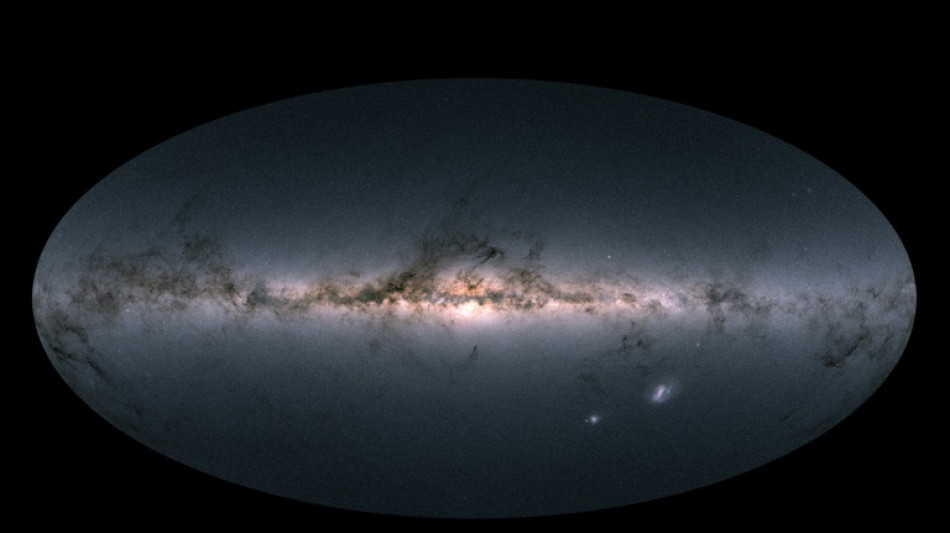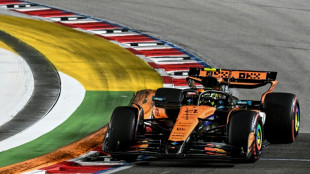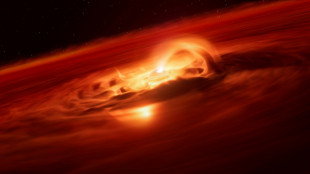
-
 Dodgers down Phillies on Hernandez homer in MLB playoff series opener
Dodgers down Phillies on Hernandez homer in MLB playoff series opener
-
Philadelphia down NYCFC to clinch MLS Supporters Shield

-
 Syria selects members of first post-Assad parliament in contested process
Syria selects members of first post-Assad parliament in contested process
-
Americans, Canadians unite in battling 'eating machine' carp

-
 Negotiators due in Cairo for Gaza ceasefire, hostage release talks
Negotiators due in Cairo for Gaza ceasefire, hostage release talks
-
Trump authorizes troops to Chicago as judge blocks Portland deployment

-
 Wallabies left ruing missed chances ahead of European tour
Wallabies left ruing missed chances ahead of European tour
-
Higgo stretches PGA Tour lead in Mississippi

-
 Blue Jays pummel Yankees 10-1 in MLB playoff series opener
Blue Jays pummel Yankees 10-1 in MLB playoff series opener
-
Georgia ruling party wins local polls as mass protests flare

-
 Depoortere stakes France claim as Bordeaux-Begles stumble past Lyon
Depoortere stakes France claim as Bordeaux-Begles stumble past Lyon
-
Vinicius double helps Real Madrid beat Villarreal

-
 New museum examines family life of Mexican artist Frida Kahlo
New museum examines family life of Mexican artist Frida Kahlo
-
Piccioli sets new Balenciaga beat, with support from Meghan Markle

-
 Lammens must be ready for 'massive' Man Utd scrutiny, says Amorim
Lammens must be ready for 'massive' Man Utd scrutiny, says Amorim
-
Arteta 'not positive' after Odegaard sets unwanted injury record

-
 Slot struggles to solve Liverpool problems after third successive loss
Slot struggles to solve Liverpool problems after third successive loss
-
Netanyahu hopes to bring Gaza hostages home within days as negotiators head to Cairo

-
 Ex-NFL QB Sanchez in hospital after reported stabbing
Ex-NFL QB Sanchez in hospital after reported stabbing
-
Liverpool lose again at Chelsea, Arsenal go top of Premier League

-
 Liverpool suffer third successive loss as Estevao strikes late for Chelsea
Liverpool suffer third successive loss as Estevao strikes late for Chelsea
-
Diaz dazzles early and Kane strikes again as Bayern beat Frankfurt

-
 De Zerbi living his best life as Marseille go top of Ligue 1
De Zerbi living his best life as Marseille go top of Ligue 1
-
US envoys head to Mideast as Trump warns Hamas against peace deal delay

-
 In-form Inter sweep past Cremonese to join Serie A leaders
In-form Inter sweep past Cremonese to join Serie A leaders
-
Kolisi hopes Rugby Championship success makes South Africa 'walk tall' again

-
 Ex-All Black Nonu rolls back the years again as Toulon cruise past Pau
Ex-All Black Nonu rolls back the years again as Toulon cruise past Pau
-
Hundreds of thousands turn out at pro-Palestinian marches in Europe

-
 Vollering powers to European women's road race title
Vollering powers to European women's road race title
-
Struggling McLaren hit bump in the road on Singapore streets

-
 'We were treated like animals', deported Gaza flotilla activists say
'We were treated like animals', deported Gaza flotilla activists say
-
Czech billionaire ex-PM's party tops parliamentary vote

-
 Trump enovys head to Egypt as Hamas agrees to free hostages
Trump enovys head to Egypt as Hamas agrees to free hostages
-
Arsenal go top of Premier League as Man Utd ease pressure on Amorim

-
 Thousands attend banned Pride march in Hungarian city Pecs
Thousands attend banned Pride march in Hungarian city Pecs
-
Consent gives Morris and Prescott another memorable Arc weekend

-
 Georgian police fire tear gas as protesters try to enter presidential palace
Georgian police fire tear gas as protesters try to enter presidential palace
-
Vollering powers to European road race title

-
 Reinach and Marx star as Springboks beat Argentina to retain Rugby Championship
Reinach and Marx star as Springboks beat Argentina to retain Rugby Championship
-
Russell celebrates 'amazing' Singapore pole as McLarens struggle

-
 Czech billionaire ex-PM's party leads in parliamentary vote
Czech billionaire ex-PM's party leads in parliamentary vote
-
South Africa edge Argentina to retain Rugby Championship

-
 'Everyone's older brother': Slipper bows out in Wallabies loss
'Everyone's older brother': Slipper bows out in Wallabies loss
-
Thousands rally in Georgia election-day protest

-
 Sinner starts Shanghai defence in style as Zverev defies toe trouble
Sinner starts Shanghai defence in style as Zverev defies toe trouble
-
Russell takes pole position for Singapore Grand Prix as McLaren struggle

-
 Robertson praises All Blacks 'grit' in Australia win
Robertson praises All Blacks 'grit' in Australia win
-
Government, protesters reach deal to end unrest in Pakistan's Kashmir

-
 Kudus fires Spurs into second with win at Leeds
Kudus fires Spurs into second with win at Leeds
-
Rival rallies in Madagascar after deadly Gen Z protests


Milky Way's secrets revealed by massive space probe map
The Gaia space probe unveiled its latest discoveries on Monday in its quest to map the Milky Way in unprecedented detail, surveying nearly two million stars and revealing mysterious "starquakes" which sweep across the fiery giants like vast tsunamis.
The mission's third data set, which will be released to eagerly waiting astronomers around the world at 1000 GMT, "revolutionises our understanding of the galaxy," the European Space Agency (ESA) said.
"It's the Swiss Army knife of astrophysics -- there is not a single astronomer who does not use its data, directly or indirectly," said Francois Mignard, a member of the Gaia team.
Some of the map's new insights are close to home, such as a catalogue of more than 156,000 asteroids in our Solar System "whose orbits the instrument has calculated with incomparable precision," Mignard said.
But Gaia also sees beyond the Milky Way, spotting 2.9 million other galaxies as well as 1.9 million quasars -- the stunningly bright hearts of galaxies powered by supermassive black holes.
The Gaia spacecraft is nestled in a strategically positioned orbit 1.5 million kilometres (937,000 miles) from Earth, where it has been watching the skies since it was launched by the ESA in 2013.
- 'Beautiful melting pot of stars' -
"Gaia scans the sky and picks up everything it sees," said astronomer Misha Haywood of the Paris Observatory.
But it can still only detect around one percent of the stars in the Milky Way, which is about 100,000 light years across.
The probe is equipped with two telescopes as well as a billion-pixel camera, which captures images sharp enough to gauge the diameter of a human hair at a distance of 1,000 kilometres (620 miles).
It also has a range of other instruments that allow it to not just map the stars, but measure their movements, chemical compositions and ages.
"It provides a global observation of the positions of anything that moves in the sky, for the first time," Haywood said, adding that before Gaia "we had a really restricted view of the galaxy".
It also reveals the huge array of differences between stars.
"Our galaxy is a beautiful melting pot of stars," said Gaia member Alejandra Recio-Blanco.
"This diversity is extremely important, because it tells us the story of our galaxy's formation," he said.
"It also clearly shows that our Sun, and we, all belong to an ever-changing system, formed thanks to the assembly of stars and gas of different origins."
- Surprise starquakes -
The observation of "starquakes", massive vibrations that change the shape of the distant stars, was "one of the most surprising discoveries coming out of the new data", the ESA said.
Gaia was not built to observe starquakes but still detected the strange phenomenon on thousands of stars, including some that should not have any -- at least according to our current understanding of the universe.
"Gaia is opening a gold mine for 'asteroseismology' of massive stars," said Gaia member Conny Aerts.
Around 50 scientific papers were published alongside the new data, with many more expected in the coming years. Gaia's observations have fuelled thousands of studies since its first dataset was released in 2016.
The second dataset in 2018 allowed astronomers to show that the Milky Way merged with another galaxy in a violent collision around 10 billion years ago.
The torrent of raw data is combed through by a team of 450 European scientists and software engineers using six supercomputers as well as "human-driven algorithms" as part of the Data Processing and Analysis Consortium, Mignard said.
"Without this processing group, there is no mission," he added, because every day Gaia produces 700 million star positions and 150 million photometric measurements.
It took the team five years to deliver the latest data, which was observed from 2014 to 2017.
"We can't wait for the astronomy community to dive into our new data to find out even more about our galaxy and its surroundings than we could've imagined," ESA's Gaia project scientist Timo Prusti said.
The final data set will be released in 2030, after Gaia finishes its mission surveying the skies in 2025.
K.Thomson--BTB




